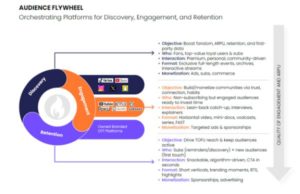
David Radoczy, COO, Three Media
It is worth stating, at the very beginning, that there is nothing inherently exciting, engaging or sexy about the cloud. Or about IP media connectivity. They are, in the very best sense of the term, enabling technologies.
What they enable is a massive cultural shift in the media industry. This is the opportunity for a completely fresh look at how we do business, how we satisfy our viewers and subscribers, and how we make money.
You will often hear people say that this is as big a change as the shift from analogue to digital. But they are wrong: it is much bigger than that. When we moved from analogue to digital we essentially carried on doing the same things in the same way, just with more efficient, more robust technology.
With IP and virtualised software architectures – whether they are in the machine room, the data centre, the cloud or some mix of all three – lifting and shifting existing workflows and working practices are not enough. It is time for a complete cultural transformation; a business and operating revolution.
Only by looking at the whole way the operation is run, and the internal resources and capabilities needed to support it, can the total opportunity on offer be realised. In an industry that is inherently conservative, that is a challenge.
In a 2022 study (commissioned by Nevion), 39% of broadcasters stated that a broadly conservative mindset to cloud was the biggest barrier to adoption. The survey found that 89% of respondents were intending to adopt cloud technologies in the coming year, which suggests that a substantial majority of broadcasters know there is something they need to be doing but are yet to identify the broader transformation aspects, beyond anything more positive than a technology refresh.
At Three Media, we talk about Next Generation Operating Strategies. That means applying smart business transformations to every aspect of production, delivery, post, content handling and orchestration, and distribution. It means sitting down with the proverbial blank sheet of paper and visualising the perfect operational flow and business model, then moulding the technology, operations and the organisational structure to realise it.
That is a big, possibly daunting task. We would break it down into five top level questions, recognising that none of them can be answered instantly or in isolation, and none are capable of one sentence answers.
First, how does the opportunity that IP and virtualised software change your current technology stack? What are the implications for support, management and hosting? How do your systems communicate with others in the wider media ecosystem?
Second, given that you are re-engineering your technology, how can this change the way you define and where you now generate the value add in your business? What key competitive skills do you need to acquire, develop and protect which will grow your business?
Third, how do you evolve your relationships with vendors and technology partners? The need to continually innovate requires you to work across a broad set of providers, partnering with those that offer the most strategic promise. How do you manage and negotiate the complexity? How do you oversee multiple systems and multiple suppliers when each one’s value to you will rise and fall and leapfrog competitors? Do you want to pay for functionality by usage, or do you need a fixed and predictable price?
Fourth, how are you going to financially re-engineer your business? How will you find your perfect balance between opex and capex and your technology investment? How do you budget and maximise variable costs when so few of our past operating assumptions now apply? Is outsourcing a risk or a way to liberate your service and product consumption? And will these decisions change over time?
And fifth – although perhaps this should be first – how will you use the new technology to change the way you interact with your customers? How do you become more valuable to your customers, and how will you evolve the products you offer to subscribers and viewers? Can you achieve greater customer satisfaction and engagement through the transformation, without losing what makes you popular today?

I am not going to answer these questions here, because there are no simple answers. This calls for a very deep dive: this is the paradigm shift you need to define for yourselves. Every organisation will have their own take on these five topics, and the top-level discussions will lead to more individual approaches.
That is the point: the absolute heart of the matter. Software defined solutions can be put together in any combination to do what you want. To get the real benefit of it, you have to decide what it is you want to achieve. The technology will follow.
But it does mean changing the culture of the organisation, to ensure that the financial and operational advantages of new technology are reflected in the new operating model you adopt.
You will find a lot of ways in which this will impact your business. Just to give one example, you can have systems and services only when you need them because yes, the cloud does allow you to switch a platform off and on, it does work. Thinking this way is transformative.
The accepted wisdom is that disaster recovery means having your defined level of backup at all times. But do you need that? You could define a business continuity structure that provides full shadow playout in the cloud during primetime for virtually instantaneous failover. But during daytime you could use less cloud processing by having, say, a five second recovery time. And midnight to 06.00 you could have a one-minute recovery. Let the commercial value determine the investment. This was not possible with legacy technologies. It is now.
To be clear, if you look at the move to virtualised software-centric technology as an evolution, you will leave money on the table. The path to success is a revolution: a revolution in the culture of your media enterprise. The goal must be, now and ever, to deliver the best content in the best quality to the most viewers. Use the opportunity of transformative technology to really define how best to do that.









